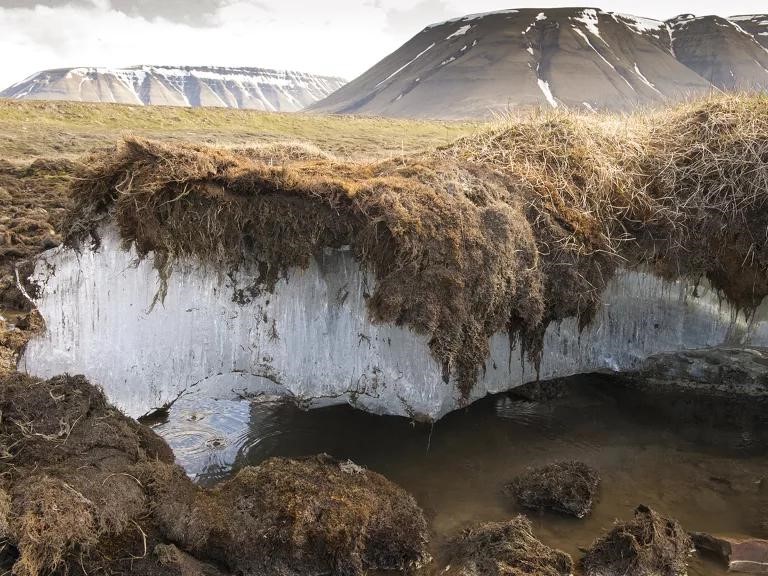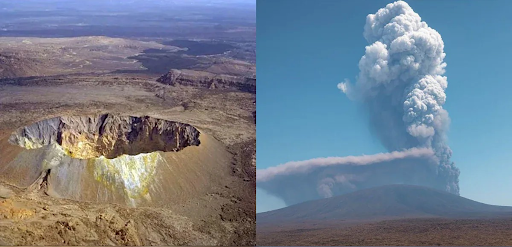Description

Disclaimer: Copyright infringement not intended.
Context
As permafrost melts as a result of climate change, it may release more radon, a colorless, odorless gas linked with lung cancer.
Details
- Permafrost, found predominantly in polar regions and high-altitude areas, is a vital component of Earth's cryosphere. It consists of soil, sediment, and rock that remain frozen year-round, often for centuries or even millennia. This frozen ground profoundly influences various environmental processes, from regulating hydrology and shaping landscapes to preserving ancient ecosystems and cultural artifacts.
Characteristics:
- Thermal Stability: Permafrost maintains temperatures below freezing (0°C) for at least two consecutive years, with some regions experiencing perennial freezing.
- Composition: It comprises a mixture of ice, water, soil, and organic matter, creating a unique matrix that defines its properties and behavior.
- Distribution: Permafrost covers vast areas of the Arctic, subarctic regions, and high mountain ranges, accounting for approximately a quarter of the Northern Hemisphere's land area.
- Ecological Significance: Permafrost ecosystems support specialized flora and fauna adapted to cold conditions, playing a crucial role in biodiversity and carbon storage.

Challenges and Concerns:
- Climate Change Impact: Rising global temperatures are causing permafrost degradation, leading to ground subsidence, thawing of ice-rich terrain, and the release of stored greenhouse gases.
- Infrastructure Vulnerability: Thawing permafrost poses significant risks to infrastructure, including buildings, roads, pipelines, and utilities, particularly in regions undergoing rapid development.
- Feedback Mechanisms: The release of methane and carbon dioxide from thawing permafrost creates positive feedback loops, amplifying climate change and further accelerating permafrost thaw.
Research and Management:
- Monitoring and Modeling: Continuous monitoring and advanced modeling techniques are essential for understanding permafrost dynamics, predicting future changes, and developing effective mitigation strategies.
- Adaptation Measures: Implementing resilient infrastructure designs, land-use planning strategies, and permafrost-aware construction techniques can help mitigate the impacts of permafrost thaw.
- International Collaboration: Addressing the challenges posed by permafrost degradation requires coordinated efforts across disciplines and international boundaries, emphasizing scientific research, policy development, and community engagement.
Recent Study
- Thawing permafrost in the Arctic could release radon, a radioactive gas that has the potential to cause cancer, scientists have warned.
- The permafrost that keeps the ground frozen year-round in the Arctic acts like a cap that prevents a variety of gases from bubbling up into the atmosphere.
- The most famous of these is probably methane, a potent greenhouse gas that is released as the permafrost thaws, thereby accelerating climate change.
- But in a new paper, researchers note that there's another dangerous gas lurking under the Arctic permafrost: This colorless, odorless gas is a step in the radioactive decay of naturally occurring uranium.
- It's known for sometimes accumulating inside homes, especially basements, thus raising the long-term risk of lung cancer for residents.
- According to the Environmental Protection Agency, radon is the second-leading cause of lung cancer in the United States, responsible for 21,000 deaths a year.

Conclusion
Permafrost serves as a critical indicator of climate change and a bellwether for environmental health in cold regions. Understanding its complexities and addressing the challenges it presents are essential for fostering sustainability, resilience, and adaptation in a warming world.
|
PRACTICE QUESTION
To what extent does permafrost degradation contribute to global climate change, and what are the implications for ecosystems, infrastructure, and adaptation strategies in cold regions?"
|












